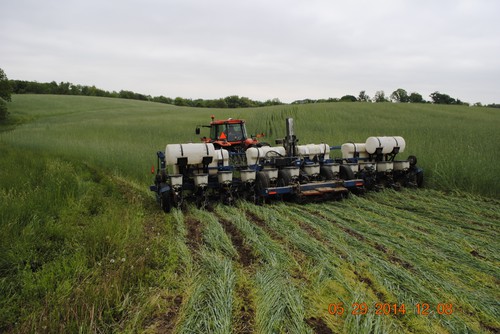Source: Penn State Extension
Planting green refers to no-till planting of primary crops into actively growing cover crops. This practice can be used when planting a grain crop like corn or soybeans into a cover crop.
This contrasts with planting into a cover crop that was killed 2 or 3 weeks before planting at a time that cover crop growth is exploding. Research has shown that by using this practice cover crop biomass can easily be doubled. Some important potential benefits of this practice include:
- Greater above- and below-ground cover crop biomass. This helps to increase water infiltration and reduce surface runoff and soil erosion.
- Legume covers will fix more atmospheric nitrogen (N) when growing an extra week or two.
- The cover crop scavenges more nutrients that might otherwise be lost by leaching to groundwater.
- The cover will take up soil moisture and help the soil to dry out and warm up quicker in periods of excess soil moisture.
- The cover crops will harvest more solar energy and increase total soil carbon important to increase water-holding capacity and nutrient pool of the soil.
- The living cover crop root system exudes labile organic compounds that feed living soil organisms in the rhizosphere. These organisms play important roles in building soil structure and nutrient recycling.
- Hairpinning problems should be eliminated or greatly reduced, because of better cutting of the green cover crop residue than that of dying crop residue that has been sprayed with herbicide but is not yet crisp and dry.
- Potentially fewer problems with slug and cutworm pests that move to the seedlings of the main crop when the cover crop is dead.
- Potentially less soil- or residue-borne disease because of reduced splash from previous crop residue and soil onto the young seedlings of the primary crop. The benefits of reduced pest and disease from planting green are still under investigation and need to be evaluated more thoroughly.
 Planting green is a new practice that is still under evaluation. Both the planter and attachments need to be in good physical condition as well as be properly adjusted.
Planting green is a new practice that is still under evaluation. Both the planter and attachments need to be in good physical condition as well as be properly adjusted.
One must be sure to account for thickness of standing or rolled plant cover when planting green. Be sure down pressure on closing wheels is set properly and seed openers are in good condition. Some no-tillers reduce the seeding rate of the cover crop so it is easier to plant through the cover crop in the spring.
Shading of the primary crop seedlings by a tall cover crop can be undesirable, especially with corn. Therefore, cover crop rollers have been designed and can be mounted on planters. These rollers flatten the cover crop onto the soil surface and part the cover crop so the double disk openers have less plant material to cut.
Soil fertility needs to be optimized when planting green in a cover crop with high carbon-to-nitrogen ratio. Microbes may absorb N from the soil to decompose the cover crop residue. These microbes may cause a N shortage for the primary crop which can be addressed by applying extra manure or N fertilizer, preferably placed close to the new seedling.
Several trials will be planted using this technique in a new research project by a group of researchers, extension educators, crop consultants and growers headed by Penn State agronomist Heather Karsten. Trials will be planted green on research and working farms in the coming month so we will learn a lot more of the benefits and challenges of this technique this year and over the following years.






Post a comment
Report Abusive Comment